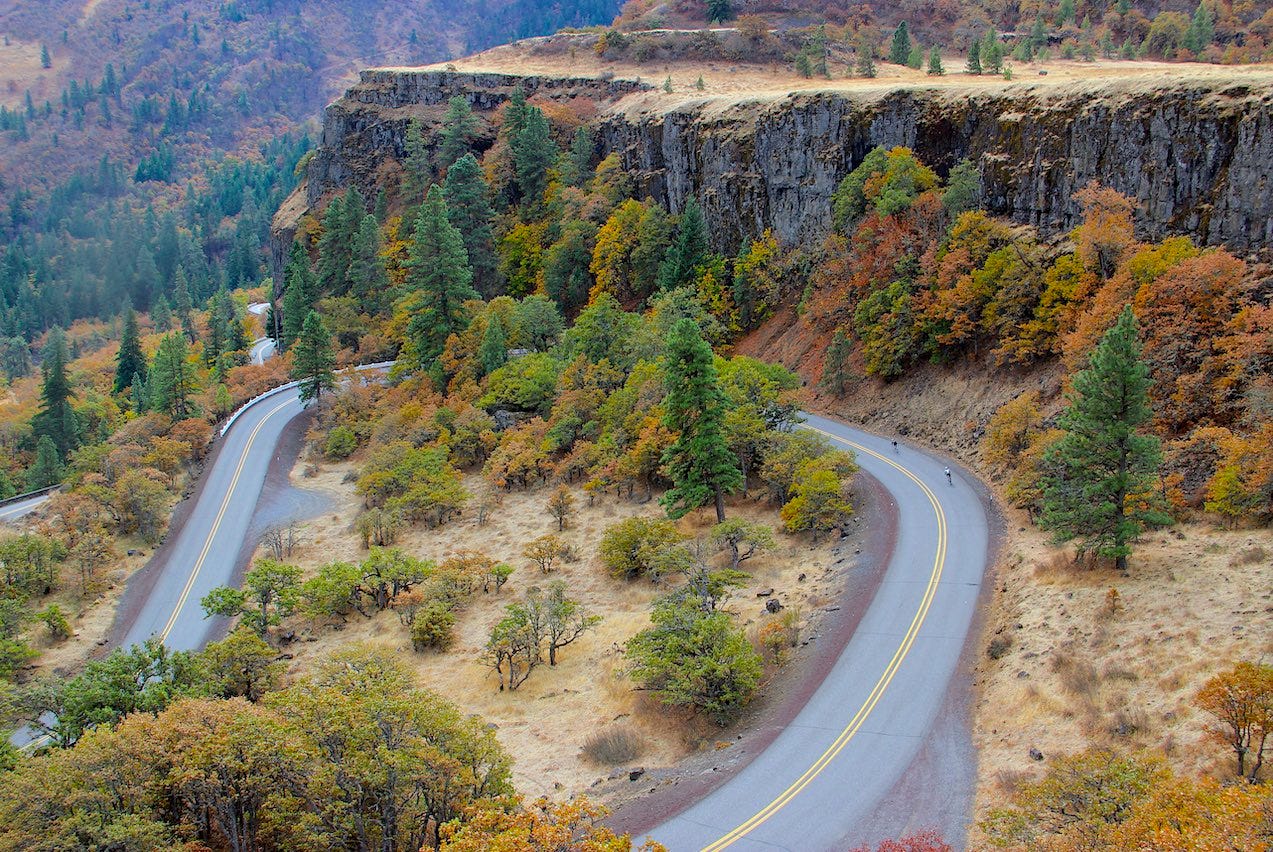Monday's postcard, and why Central Washington University's Nick Zentner is a national treasure
November 27, 2023
Cyclists whipping down the historic Columbia gorge highway (U.S. 30) just below the Rowena crest, east of Mosier, Oregon
It turns out there’s only been one dinosaur fossil found in Washington state. It was a major discovery in 2012—a good chunk of leg bone found by researchers from the Burke Museum in marine rock on the shoreline of Sucia Island in the San Juans. Due to its size and close resemblance to a Tyrannosaurus Rex, the remnant bone took on the name of Suciasaurus. Earlier this year, Governor Inslee signed a bill designating Suciasaurus as Washington’s official dinosaur.
There is an important asterisk to Suciasaurus in the San Juans because it turns out the state dinosaur actually never walked anywhere near Washington. I learned about this from, well, who else?
Nick Zentner
More on the fossil below. But first, the backstory on Nick who, I just learned, has been decorated with the Geological Society of America’s 2023 Public Service Award. It’s a big deal, and richly deserved.
Nick is from Wisconsin but has been teaching geology at Central Washington University in Ellensburg for two decades. He has a world-wide following, on-line, for his Pacific Northwest-based geology lessons—which range from carefully scripted television spots, to chalkboard-heavy classroom lectures, to lengthy field trips that he narrates on the fly using an iPhone camera on a stick-mount. For the past five years, he’s also produced a regular geology podcast.
The guy can really talk and really teach. During Covid he did live video broadcasts from his backyard in Ellensburg, where he could spread out his maps, read from highlighted manuscripts, sample libations, and show videos from a sun-shielded contraption he called “the cozy fort.”
He also does things few other science teachers would attempt—as he did a couple years ago when he gathered P’squosa-Wenatchi elder and story-teller Randy Lewis-K’ayaxan and used his camera to capture Randy’s accounts of Native American history, practices, and legends embodied in the rivers, rocks and canyons of the lower Columbia basin.
I found Nick’s work in 2016 and finally got to meet him, in early 2020, just before Covid shut everything down. I’d been invited to display my Beautiful Wounds photography in the main gallery at the Moses Lake Museum and Nick was there, opening night, to present a lecture on the Ice Age floods before a nearly full house in the museum’s auditorium. With him he’d brought a video to illustrate what one of the great floods would have looked like as it engulfed Dry Falls—the massive cataract the floods created, some 17,000 years ago—just south of Coulee City. As the view widens near the end of the video we see state Highway 17—which runs along the western edge of the Dry Falls gorge—and then a real Winnebago racing south on the highway to stay ahead of the wall of convulsing floodwaters. The auditorium roared with laughter.
It’s next to impossible to pick a favorite among his lectures, but for starters, I’ll go with his Exotic Terranes of the Pacific Northwest public lecture from five years ago, in which he addresses the Sucia Island dinosaur and the prevailing theory of how it arrived in the San Juans, long after it had lived its dinosaur-life perhaps a thousand miles or so south of the Evergreen state. It highlights one of the major surprises of the U.S. west coast, which is how much of it consists of terranes that arrived from the south and west, to dock against what used to be the coast. (If Spokane had existed 200-350 million years ago, it would have been as a coastal city.)
There are some favorite moments. But one, in particular, is pretty special. I’ll have to admit, in closing, that Nick’s work isn’t just interesting to me, it fills something akin to a dietary need for my psyche.
These are tough times for many of us to get through for reasons I’ve written about, not the least of which is the depressing attacks on science and reason that intrude like a debilitating fungus into our politics and civic discourse. Zentner is a devout student as well as a teacher and when he learns of a new twist in a problem or discovery that interests him he often responds to it with gusto and joy. So he models learning as well as teaching and the process that encompasses both—the care, the listening, and sometimes the thinking out loud part. It’s inspiring and often humorous. It lifts our humanity.
A couple years ago he showed up at Grand Coulee to shadow a cadre of some of America’s most renowned, senior research geologists who were attending a Geological Society of America field trip in and around Grand Coulee and Steamboat Rock. He was walking and talking and wondering aloud about whether or how to engage the band of eminent, aging rock stars when he just finally dove in and joined them on their hike on a shoreline near Steamboat Rock.
At 27:50 minutes into the video, Nick’s camera briefly pans to a man in a dark blue ball cap, beige jacket and a backpack. As Zentner turns back toward the shoreline we hear, “Excuse me. I’d like to introduce myself.”
“I’m Jim,” the man in the blue hat tells him, “I’m a big fan of all your videos.”
“Well, I’m Nick,” Zentner replies, “it’s nice to meet you Jim.”
“This is so cool, to meet you,” Jim says with an engaging smile and a handshake. He tells Nick he’s a geologist who lives and works in New Hampshire. Their conversation progresses and then Jim pauses, clears his throat and looks Zentner fully in the eyes.
“I just want to thank you for everything you did, because you’ve done a lot for the profession, in a very challenging time for a lot of people.”
Amen to that. And congratulations to Nick.
—tjc






